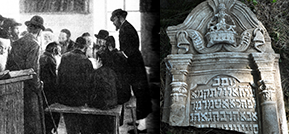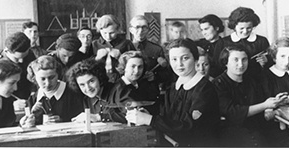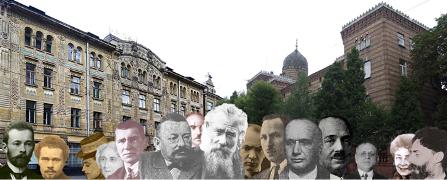The international conference The Ukrainian and Jewish Artistic and Architectural Milieus of Lwów/Lemberg/Lviv: From Ausgleich to the Holocaust took place on November 5–7, 2012, in Lviv, Ukraine.
The conference was organized by The Center for Urban History of East Central Europe (Lviv, Ukraine), The Center for Jewish Art, Hebrew University of Jerusalem (Israel), The Polish Institute of World Art Studies (Warsaw, Poland), The Leonid Nevzlin Research Center for Russian and East European Jewry (Jerusalem, Israel), and The Ukrainian Jewish Encounter Initiative (Toronto, Canada)
The conference was generously supported by The Jewish Galicia and Bukovina Association (Jerusalem, Israel), Mr. William L. Gross, Collector (Tel Aviv, Israel), The Euro-Asian Jewish Congress (Kyiv, Ukraine), and The Solomiya Krushelnytska Musical Memorial Museum (Lviv, Ukraine).
The conference was hosted by the Center for Urban History of East Central Europe in Lviv. During three days of the conference, twenty eight topics were presented by researchers coming from Australia, France, Israel, Poland, Ukraine, and USA. The topics covered a vast variety of fields, including history of art, architecture, sculpture, cinema, and music. A great deal of the program was dedicated to the theory of Jewish, Polish and Ukrainian national art in the 19th and 20th centuries, to the matters of artists’ identification and self-identification. The researchers’ interests were largely concentrated on individuals active in Lviv and beyond. An unusual trait of an academic conference was participation of descendants from the city’s artistic families, those of Awins, Hermelins, Liliens, and Misess. Their lectures established an emotional contact with the audience, further enhanced by a spectacular concert of traditional klezmer music given by the conference participants, and by the following discussion of the tragic artists’ destiny in the Holocaust and World War II. The conference was considered very successful by its participants and organizers; it was decided to publish its materials, and to plan another conference in coming years.
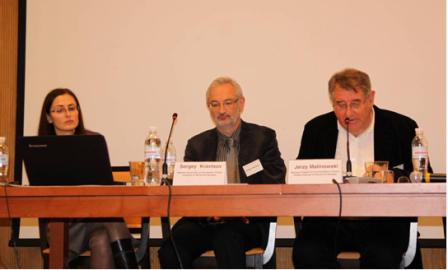 The conference started with the greeting words by Dr. Iryna Matsevko, Prof. Jerzy Malinowski, and Dr. Sergey Kravtsov.
The conference started with the greeting words by Dr. Iryna Matsevko, Prof. Jerzy Malinowski, and Dr. Sergey Kravtsov.
The first session, mediated by Dr. Marina Dmitrieva of The Leipzig University, was dedicated to the Artistic Identities.
Professor Jerzy Malinowski of The Nicolaus Copernicus University in Toruń, and the President of The Polish Institute of World Art Studies, delivered a lecture “The Art of Wilhelm Wachtel: Problems of Style and Iconography.”
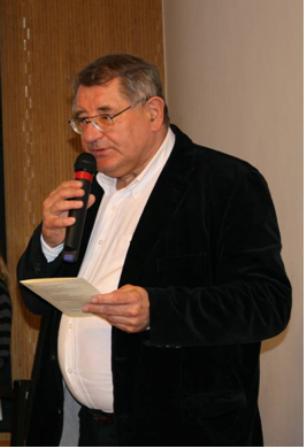 “In the study of Jewish art of the recent 20 – 30 years, the following issues are particularly discussed: the contribution of art to the propaganda of the idea of Zionism, and the genesis of the so-called Jewish "national style" of the late 19th and early 20th century. The political and cultural concepts of Zionism developed mainly in the German language area - in Vienna (where Herzl worked), Berlin, Frankfurt, as well as the Russian one - including Odessa, and Polish - Warsaw, Vilna and Lwów. However, in the sphere of art and visual propaganda, the Jewish artists originating from Poland played a key role, which became transparent among other things in connection with the Exhibition of Jewish Artists in Berlin in 1907. The artists came from the milieus of Warsaw and Lodz, as well as Krakow and Lwów.
“In the study of Jewish art of the recent 20 – 30 years, the following issues are particularly discussed: the contribution of art to the propaganda of the idea of Zionism, and the genesis of the so-called Jewish "national style" of the late 19th and early 20th century. The political and cultural concepts of Zionism developed mainly in the German language area - in Vienna (where Herzl worked), Berlin, Frankfurt, as well as the Russian one - including Odessa, and Polish - Warsaw, Vilna and Lwów. However, in the sphere of art and visual propaganda, the Jewish artists originating from Poland played a key role, which became transparent among other things in connection with the Exhibition of Jewish Artists in Berlin in 1907. The artists came from the milieus of Warsaw and Lodz, as well as Krakow and Lwów.
The Galician milieu (Krakow and Lwów) of around 1900 gained importance thanks to the group of graduates of the Krakow School (since 1900 Academy) of Fine Arts who were born in the 1870s - Arthur Markowicz from Krakow, Efraim Maurycy (Ephraim Moses) Lilien and Leopold Gottlieb, both from Drohobycz, and Wilhelm Wachtel, born in Lwów. Samuel Hirszenberg from Lodz, educated in the Krakow School earlier, was also temporarily connected to this circle…”
Dr. Małgorzata Stolarska-Fronia of The Museum of the History of the Polish Jews in Warsaw, and The Polish Institute of World Art Studies presented her lecture on “The Work of Ephraim Moses Lilien in Lviv.” As Dr. Małgorzata Stolarska-Fronia could not arrive to Lviv, the lecture was delivered on Skype. Thanks to this technical “miracle,” the audience was able to communicate with the lecturer, and she was able to participate in general discussion.
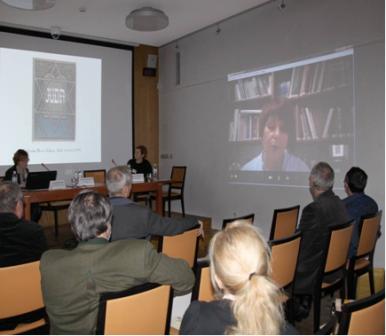 “For the Zionist movement Lilien was a perfect candidate for channeler of the idea of Zionism – one of the most common traits attributed to him by the pro-Zionist critic, was a natural ability to connect features of east and west (Ost und West, nomen omen, as was the title of propaganda, lavishly illustrated journal of German Zionists), equally emphasizing his working-class origins. Considerable influence on the perception of the artist and his work took its origin in his youth years spent in Drohobych and Lviv. This image has become a part of self-creation of the artist. The legend and myth of the artist, who escaped from a poor shtetl toward universal culture – read civilization – and finally he reached the advancement that enable him to be involved in helping his co-religionists, suffers from the lack of information about real experiences of the artist in Drohobych and Lviv. The relationship, especially with the political and cultural communities of the city must be closely examined. Following his contacts and ideological inspirations, it seems that the forming experience for his beliefs as well as his artistic and political choices originated from the Lviv milieu…”
“For the Zionist movement Lilien was a perfect candidate for channeler of the idea of Zionism – one of the most common traits attributed to him by the pro-Zionist critic, was a natural ability to connect features of east and west (Ost und West, nomen omen, as was the title of propaganda, lavishly illustrated journal of German Zionists), equally emphasizing his working-class origins. Considerable influence on the perception of the artist and his work took its origin in his youth years spent in Drohobych and Lviv. This image has become a part of self-creation of the artist. The legend and myth of the artist, who escaped from a poor shtetl toward universal culture – read civilization – and finally he reached the advancement that enable him to be involved in helping his co-religionists, suffers from the lack of information about real experiences of the artist in Drohobych and Lviv. The relationship, especially with the political and cultural communities of the city must be closely examined. Following his contacts and ideological inspirations, it seems that the forming experience for his beliefs as well as his artistic and political choices originated from the Lviv milieu…”
Mrs. Monika Czekanowska of The Adam Mickiewicz University in Poznań presented her lecture “Biblical Motifs in the Works of Maurycy Gottlieb and Ephraim Moses Lilien.”
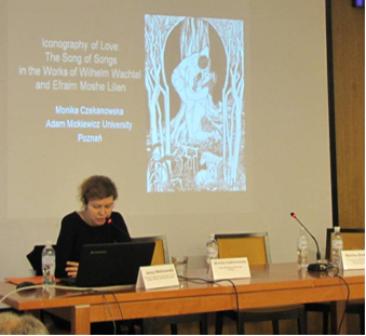 "Although the Song of Songs was the topic of various literary and artistic works in Christian and Jewish art, it has not been properly investigated. This paper aims to help to fill this gap by examining the representations of the Song of Songs in selected works by Wilhelm Wachtel and Efraim Moshe Lilien, Jewish artists who were connected with Lviv, where they partly lived and exhibited their works. In this presentation we will discuss the following issues: How do Wachtel and Lilien treat the metaphoric description of the bride from the Song, and deal with the dilemma of the complexity of the narrative of the Book? How do they read the selected passages of the Song of Songs? What are their sources? How do the scenes from the Song and the portraits of the women by Jewish artists differ from Christian images and what can account for these differences? When discussing the representations of the chosen Biblical passages, short interpretations by current commentators will be given first. We will then explore the iconography of the illustrations and analyze the tension between the iconography and the Biblical narrative…”
"Although the Song of Songs was the topic of various literary and artistic works in Christian and Jewish art, it has not been properly investigated. This paper aims to help to fill this gap by examining the representations of the Song of Songs in selected works by Wilhelm Wachtel and Efraim Moshe Lilien, Jewish artists who were connected with Lviv, where they partly lived and exhibited their works. In this presentation we will discuss the following issues: How do Wachtel and Lilien treat the metaphoric description of the bride from the Song, and deal with the dilemma of the complexity of the narrative of the Book? How do they read the selected passages of the Song of Songs? What are their sources? How do the scenes from the Song and the portraits of the women by Jewish artists differ from Christian images and what can account for these differences? When discussing the representations of the chosen Biblical passages, short interpretations by current commentators will be given first. We will then explore the iconography of the illustrations and analyze the tension between the iconography and the Biblical narrative…”
The second session, mediated by Prof. Jerzy Malinowski, was dedicated to the Artists and their Milieus. The lecture presented by Dr. Małgorzata Geron of The Nicolaus Copernicus University in Toruń, and of the Polish Institute of World Art Studies, was dedicated to the “The Formist Art in Lviv.”
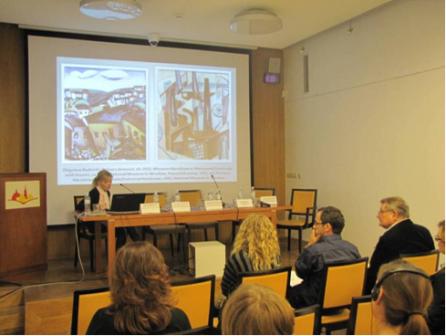 “In the summer of 1913 Lviv hosted The Exhibition of Futurists, Cubists and Expressionists organized by Herward Walden, the founder of Der Sturm gallery’s magazine. Despite its broad-ranging title, the exhibition presented mostly works by Expressionists, e.g. Alexej von Jawlensky, Wassily Kandinsky, César Klein, Ludwig Meidner, Wilhelm Morgner, Hans Richter, Arthur Segal as well as a Czech Cubist, Bohumil Kubišta, whose painting, Vražda [Murder] was put on the poster advertising the event designed by Józef Wodyński.
“In the summer of 1913 Lviv hosted The Exhibition of Futurists, Cubists and Expressionists organized by Herward Walden, the founder of Der Sturm gallery’s magazine. Despite its broad-ranging title, the exhibition presented mostly works by Expressionists, e.g. Alexej von Jawlensky, Wassily Kandinsky, César Klein, Ludwig Meidner, Wilhelm Morgner, Hans Richter, Arthur Segal as well as a Czech Cubist, Bohumil Kubišta, whose painting, Vražda [Murder] was put on the poster advertising the event designed by Józef Wodyński.
The exhibition was the first presentation of avant-garde art in Lviv and in general gained negative reviews from local art critics. The authors of the reviews, Celina Stoińska, Artur Schröder and Władysław Kozicki, expressed their open reluctance to presented works; it was the confirmation of their conservatism and the lack of knowledge on modern art…”
The lecture by Dr. Ilia Rodov of The Bar-Ilan University in Ramat Gan was entitled “Between the Lost Empire and Messianic Paradise: Maksymilian Kugel’s Synagogue Paintings.”
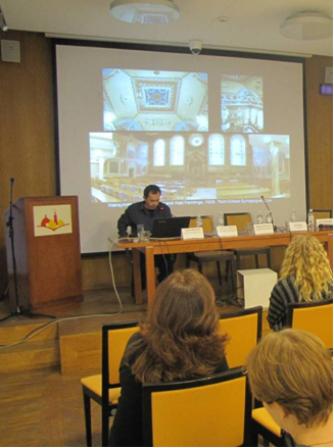 “The case representing the complex identity of a Jewish artist in interwar L’viv that I’d like to focus on in my presentation is the paintings in the Tzori Gilead synagogue at the former Kościopalni Street, now Mikhnovsky Brothers Street. The synagogue was built by Albert Kornblüth in 1925. The wall and ceiling paintings are attributed to certain Maksymilian Kugel in an anonymous report about completing the paintings in Lviv’s newspaper Chwila in July 1936. The article informs that Kugel was a pupil and assistant of certain Master Falkenstein in Vienna and the Fleck Brothers in Lviv. Maksymilian Kugel started his professional education in the early 1900s. Like his elder brother Joseph, a fashion tailor, Maksymilian went to study profession in Vienna and then came back to Lviv by 1910, when Maksymilian was mentioned in the Lviv address book as an “artistic painter.”
“The case representing the complex identity of a Jewish artist in interwar L’viv that I’d like to focus on in my presentation is the paintings in the Tzori Gilead synagogue at the former Kościopalni Street, now Mikhnovsky Brothers Street. The synagogue was built by Albert Kornblüth in 1925. The wall and ceiling paintings are attributed to certain Maksymilian Kugel in an anonymous report about completing the paintings in Lviv’s newspaper Chwila in July 1936. The article informs that Kugel was a pupil and assistant of certain Master Falkenstein in Vienna and the Fleck Brothers in Lviv. Maksymilian Kugel started his professional education in the early 1900s. Like his elder brother Joseph, a fashion tailor, Maksymilian went to study profession in Vienna and then came back to Lviv by 1910, when Maksymilian was mentioned in the Lviv address book as an “artistic painter.”
The lecture Dr. Katarzyna Kulpińska, Nicolaus Copernicus University in Toruń, and The Polish Institute of World Art Studies, was dedicated to the “Graphics by Leopold Lewicki in Kraków and Lviv Milieus.”

Class struggle Spider Interrogation of a pioneer

Prayer Love under No 13 Mikveh (Jewish ritual bath)
Prof. Dr. Olena Bystrova of The Drohobych State Pedagogical University lectured about “The Art and Fate of Bruno Schultz in the Polish-Jewish-Ukrainian Context.”
 “The history of Drohobych is closely connected with Bruno Schulz’s life and creative work. Bruno Schulz (July 12, 1892 – November 19, 1942) was a Jewish-Polish writer, fine artist, literary critic and art teacher, regarded as one of the great Polish-language prose stylists of the 20th century. Schulz was born in Drohobych, in the province of Galicia, and spent most of his life there.
“The history of Drohobych is closely connected with Bruno Schulz’s life and creative work. Bruno Schulz (July 12, 1892 – November 19, 1942) was a Jewish-Polish writer, fine artist, literary critic and art teacher, regarded as one of the great Polish-language prose stylists of the 20th century. Schulz was born in Drohobych, in the province of Galicia, and spent most of his life there.
His works The Street of Crocodiles, The Cinnamon Shops, Sanatorium under Clepsydra, were created under the impact of Drohobych atmosphere of those days. Before turning to literature, Schulz was successful as an artist and his works are considered significant to this day. The year 1992 two was named The Year of Bruno Schulz by UNESCO, commemorating the 100th anniversary of his birth, and the 50th anniversary of his death at the hands of a Nazi officer in the Jewish ghetto of Drohobycz. In 2001, the discovered Schulz’s murals were exhibited at Yad Vashem – the Holocaust Martyrs' and Heroes' Remembrance Authority...”
The third session was entitled Artist and Legacies: Józef Awin in Lviv and Beyond, and it was dedicated to the life, creativity, and legacy of one of outstanding figures of the artistic Jewish Lviv. The session was mediated by Dr. Ilia Rodov.
The lecture by Dr. Sergey Kravtsov of The Hebrew University of Jerusalem, and The Polish Institute of World Art Studies, discussed the observations by Józef Awin on Jewish Visual Culture.
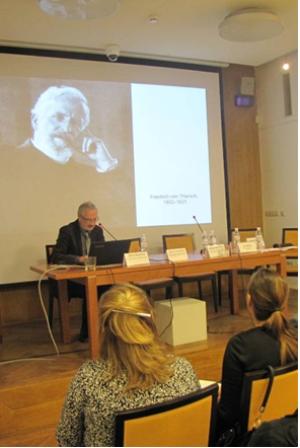 “It might be said that Awin, who was born into the traditional Jewish eastern European milieu, started his professional training in Lviv in 1902, polished it in Vienna and Munich and returned to work in his home city in 1907, was highly acclaimed as an architect and as an author. This was largely due to the ideology awakened by Martin Buber and the Ost and West review, which saw the “authentic folk” of eastern European Jewry as the revitalizing force for their western assimilated brethren, in the name of Jewish solidarity and emerging self-awareness.”
“It might be said that Awin, who was born into the traditional Jewish eastern European milieu, started his professional training in Lviv in 1902, polished it in Vienna and Munich and returned to work in his home city in 1907, was highly acclaimed as an architect and as an author. This was largely due to the ideology awakened by Martin Buber and the Ost and West review, which saw the “authentic folk” of eastern European Jewry as the revitalizing force for their western assimilated brethren, in the name of Jewish solidarity and emerging self-awareness.”
“We discover another Awin—a Zionist thinker—in the article on the artist Wilhelm Wachtel, published in 1915 in Múlt és Jövő (Past and Future). Contemplating on Wachtel’s work The Passerby, he proceeds to the Zionist teleology: “We are ‘passersby’ on the streets of metropolitan Europe, as we are in the narrow ghetto streets. And we believe that one day we will behold the new spring in the Holy Land.”
“And still, Awin was seeking for the bond which could determine the continuity and consistency of Jewish visual culture in the past, in other words, the very existence of Jewish visual tradition. In his article “On Old Jewish Art” of 1935, Awin reiterated the re-emerging thirst of every nation to discover its own distinctive features. He mentions the successes and difficulties of Jewish researchers on this path, and expresses his trust in a detection of “one continuous line.” Awin points out the work by the Carcovian scholar Zofia Ameisenowa, who pursued the idea of Jewish iconography, “integrity of motifs … and their continuity until the mid-19th century,” as giving hope for such a solution...”
The lecture by Iuliia Bohdanova of The Lviv Polytechnic National University was entitled “Architect Józef Awin: Practical Activity in Lviv.”
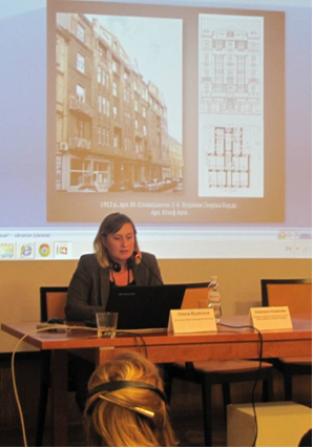 “When asked ‘what is associated with the notion of the Lviv Jewish culture’? – the things that come to mind are the secular and ritual silver objects, white elegant lace stored in Lviv museums, the Renaissance synagogue “The Golden Rose” in the Old Town, as well as the terrible events of World War II, and their sad consequences. The contribution by the Jewish community in the development of the city in the late 19th – early 20th centuries, the period of its greatest development, is not sufficiently researched. Social activity of the Jewish people at that time is mainly perceived as a part of general national cultural process. This is caused by partial assimilation of Jews, which drew the results of their activity beyond folk tradition. For example, the study of the early twentieth century buildings designed by Jewish architects encounters a difficulty to determine the degree of ethnic identification of these objects. It points to the discontinuity of the bond between generations. One of the means that enable to analyze and understand the phenomenon of Jewish culture and architecture of the late 19th – early 20th centuries is the study of the work by particular personalities. Their activism helped to preserve and promote the achievements of past generations and to define the basic vectors for further development. One of the brightest Jewish Lviv architects of that period was Joseph Awin. His works includes a large set of public and residential buildings, located in diverse parts of the city, and comprising a real gem of this city...”
“When asked ‘what is associated with the notion of the Lviv Jewish culture’? – the things that come to mind are the secular and ritual silver objects, white elegant lace stored in Lviv museums, the Renaissance synagogue “The Golden Rose” in the Old Town, as well as the terrible events of World War II, and their sad consequences. The contribution by the Jewish community in the development of the city in the late 19th – early 20th centuries, the period of its greatest development, is not sufficiently researched. Social activity of the Jewish people at that time is mainly perceived as a part of general national cultural process. This is caused by partial assimilation of Jews, which drew the results of their activity beyond folk tradition. For example, the study of the early twentieth century buildings designed by Jewish architects encounters a difficulty to determine the degree of ethnic identification of these objects. It points to the discontinuity of the bond between generations. One of the means that enable to analyze and understand the phenomenon of Jewish culture and architecture of the late 19th – early 20th centuries is the study of the work by particular personalities. Their activism helped to preserve and promote the achievements of past generations and to define the basic vectors for further development. One of the brightest Jewish Lviv architects of that period was Joseph Awin. His works includes a large set of public and residential buildings, located in diverse parts of the city, and comprising a real gem of this city...”
Dr. Zhanna Komar of The Research Institute of European Heritage, International Cultural Centre in Kraków, delivered her lecture “Józef Awin in Stanisławów Voivodeship.”
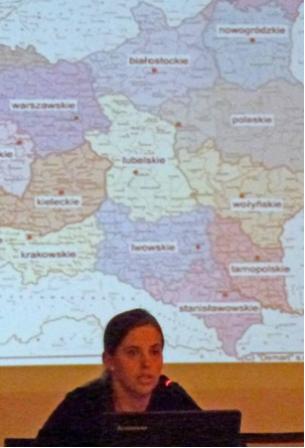
“The evolution of ideas, the factor of human activity was contributing to the importance of city. A new pattern of sociality emerged from the general trends within the early interwar period. The people of distinct active position stepped forward on the social scene. The belief in possibility and importance of action grew among masses. The number of public associations began to multiply in the late nineteenth century in Galicia. Then, and this is symbolic because of 1868, the year when Galicia became autonomous, was founded a public association, which initiated and executed one of the objects of our story. This community originally appeared under the name the Rigorizants’ Society, later renamed The Jewish Society of Academic House in Lviv. The hero of our story, Joseph Avin was closely linked with this association, as he participated in the reconstruction of Lviv House of the Society in 1909. The erected building, called like the society The Jewish Academic House in Lviv, featured Moorish style, and about its inauguration wrote the magazine Czas Krakoski in August 1909 …”
“It is striking, how the descriptions of the building’s layout with its roentgen room in the basement, and the rules of conduct, which accompany the endless dialogues of Thomas Mann’s The Magic Mountain, all these passages are echoed in Josep Awin’s new design for the tuberculosis sanatorium in Vorokhta. In addition, there are Awin’s detailed descriptions and functional explanations for every element of his design…”
Mrs. Sylvia Yoma Tarquine, an independent researcher, and Joseph Awin’s granddaughter, form Fort Lauderdale (US), delivered a lecture “Józef Awin’s Legacy.”
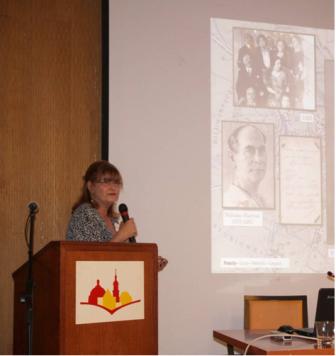 “Josef Awin was a well known Jewish architect. He was an art historian, collector, and philanthropist involved in Jewish monument and art restoration projects throughout Eastern Europe. He was also my grandfather. Until very recently little was known of Awin’s personal life, except what our mother, Hanka Awin, told us and what we saw in the few photos she had, and a portrait of Wanda, our grandmother, that was in our house.
“Josef Awin was a well known Jewish architect. He was an art historian, collector, and philanthropist involved in Jewish monument and art restoration projects throughout Eastern Europe. He was also my grandfather. Until very recently little was known of Awin’s personal life, except what our mother, Hanka Awin, told us and what we saw in the few photos she had, and a portrait of Wanda, our grandmother, that was in our house.
These past few years have been an amazing journey as we learned about the far-reaching work our grandfather accomplished in his short life… We were able to get a better idea of what a remarkable man he was and in a very magical way, we, his grandchildren, were able to realize his unspoken and, until now, unknown , influence in our individual lives.
This conference has been a wonderful way to recognize and honor Josef Awin. This presentation will focus on his personal history and how his legacy has shaped his descendants… “
The fourth session was dedicated to Shaping and Marking Urban Space, and it was mediated by Dr. Vita Susak of The Lviv National Art Gallery.
Dr. Iurii Biriulov of Lviv Polytechnic National University delivered a lecture “The Work of Jewish Sculptors in Lviv, 1919–1941.”
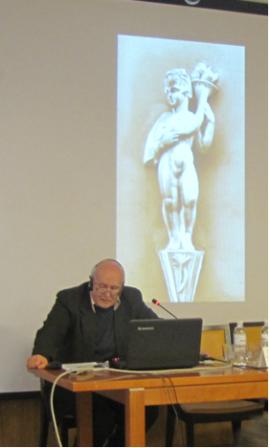 “This paper briefly discusses sculpture produced by Jewish artists during the interwar decades and at the beginning of World War II. Due to the intensification of social and political life, the Jewish plastic art flourished in the city. Alongside with their attempts to charge their works with national and religious ideas, to continue artistic traditions of Galician Jews rooted in the 16th – 17th centuries, the sculptors turned to a wide range of universal artistic techniques and varied styles, genres, and subjects. At this time, they used elements of Academism, Symbolism, Impressionism, Art Deco, Expressionism, Cubism, Neoclassicism, Social Realism and other artistic trends.
“This paper briefly discusses sculpture produced by Jewish artists during the interwar decades and at the beginning of World War II. Due to the intensification of social and political life, the Jewish plastic art flourished in the city. Alongside with their attempts to charge their works with national and religious ideas, to continue artistic traditions of Galician Jews rooted in the 16th – 17th centuries, the sculptors turned to a wide range of universal artistic techniques and varied styles, genres, and subjects. At this time, they used elements of Academism, Symbolism, Impressionism, Art Deco, Expressionism, Cubism, Neoclassicism, Social Realism and other artistic trends.
The origins of flourishing Jewish sculpture in Lviv lie in the late 19th century. For a long time, Jewish sculptors were engaged mainly in carving gravestones for the Old and New cemeteries. Thus, from the 1870s until the early 20th century this craft was practiced by the Judem Family – by Abraham (born in Lviv in 1848) and Mayer (born in Lviv, 1844), and by Isaac Mandel with his son Hersch. In Judems’ workshops located in 4 Szpitalna St., 10 Pilichowskich St., and 2 Rappaporta St., the headstones were produced according to the traditions of 16th – 18th centuries. However, not only the local sandstone was used there; they employed the imported marble, granite, syenite, and labradorite. Gersh Mandel and Markus, son of Mayer Judem, founded a joint venture in the early 20th century, and it operated well in 1920s. Judem’s heir Leib Mandel was running a shop at 16 Pilihovskich St., and he put tombstones at the New Jewish Cemetery until 1939…”
Mrs. Olena Iakymova of The Lviv National Academy of Art delivered a lecture “Early Twentieth Century Lviv Figurative Sculpture: Architectural Context.”
 “Since its foundation, Lviv has been the city that experienced, accepted, and transformed the history and culture of many nations. Lviv has managed to combine their artistic traditions into a unique single ensemble of historical and architectural heritage. The most current Western European trends were quickly absorbed and interpreted according to existing, somewhat provincial, but very ambitious aspirations of the city’s leading residents – politicians, affluent landlords, scholars, writers, and artists. Modern achievements of technology, scholarship, and art gained wide currency.
“Since its foundation, Lviv has been the city that experienced, accepted, and transformed the history and culture of many nations. Lviv has managed to combine their artistic traditions into a unique single ensemble of historical and architectural heritage. The most current Western European trends were quickly absorbed and interpreted according to existing, somewhat provincial, but very ambitious aspirations of the city’s leading residents – politicians, affluent landlords, scholars, writers, and artists. Modern achievements of technology, scholarship, and art gained wide currency.
The late nineteenth and early twentieth century became a critical period, foreshadowing a turn from the artist as a representative of a style to the artist as seeker of individual expression through creation. Even a customer-dependent monumental art tried to follow this path. However, unlike figurative murals, usually used to decorate sacred objects, which established limitations of form and narrative, sculpture could be treated more freely. For this reason, it is precisely in monumental plastics, that artists could turn to the cutting-edge achievements of current art. Works from the discussed period are characterized by the search for new forms and expressive means….”
Mr. Ihor Siomochkin of Institute “Ukrzakhidproektrestavratsiia” in Lviv delivered a lecture “Semantics of Sacred Buildings in the Projects by Julian Zachariewicz.”
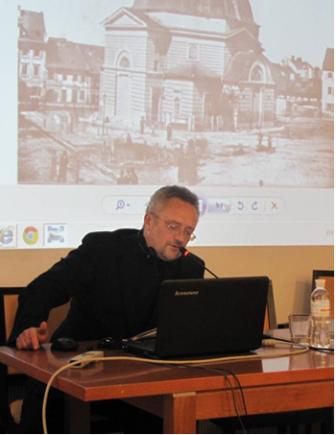 “The present paper discusses the theoretical underpinnings of Zachariewicz’s sacred building designs, as well as the symbolic significance of architectural solutions for churches of various denominations.
“The present paper discusses the theoretical underpinnings of Zachariewicz’s sacred building designs, as well as the symbolic significance of architectural solutions for churches of various denominations.
The architect paid much attention to the national aspect: a church for him was the reflection of the nation’s spirit. Zachariewicz postulated the main points of his vision in “On National Art” (“O sztuce narodowej”), his inaugural address as the Rector of the Lviv Polytechnic in 1881.
At the start of his address Zachariewicz stressed, that national art is the testimony of the victory of the human spirit at certain chronological stage and in certain region; and, at the same time, it is the result of the achievements of humanity as a whole. Simultaneously, the architect defined the concept of national art – an idea, which in the current (nineteenth) century occupied “the thoughts and feelings of every person.” Zachariewicz stressed that “construction is the most objective of all the elements of art,” that architecture gives most realistic manifestation to social relations, for which reason, it is the art that should reflect the national features of art. According to Zachariewicz, healthy creative conditions would arise when all of society understands art as an “expression of its own spiritual life, family imagination, and feelings…”
The fifth session was dedicated to Artists and Communities, and it was mediated by Mrs. Iuliia Bohdanova
Dr. Magdalena Kunińska of The State Higher Vocational School in Oświęcim, presented her lecture on The Views of Professor Marian Sokołowski on Ruthenian Art. Because of Dr. Kunińska’s absence, her paper was read by Mrs. Monica S. Yoma Awin, granddaughter of Joseph Awin.
“In 1880 Marian Sokołowski, a private-docent of “art history and archaeology” at Jagiellonian University (and then the first, who held an academic chair of art history in former Poland) expressed the title excerpt of this paper during the First Polish Historical Meeting dedicated to Jan Długosz. It was just a year before he was appointed the chair of art history at the university. It was a part of his programmatic paper concerning the need of research and publication of architectural monuments in former Poland. Hundred and fifteen years later, Robert S. Nelson entitled his article “Living on the Byzantine Borders of Western Art,” and I have to admit that the linguistic resemblance of those statements became impulse to write this text. Investigating further we can find other analogies. Sokołowski delivered his speech in a kind of initial situation for Polish art history as academic discipline and he included a list of postulates to create his vision of its scientific paradigm. Nelson worked in situation when our discipline was brought to reflection over its origins in postmodern and postcolonial time. It became obvious that the former model is highly western-centered, and more generally, that investigating in the past is never neutral, for it always serves present goals of extra-academic character (e.g. political, nationalistic etc)…”
Ms. Veronika Drohobytska of Jagiellonian University in Kraków delivered a lecture “Ryszard Hermelin and Zygmunt Sperber: Architectural Projects in Lviv and Truskavets.”
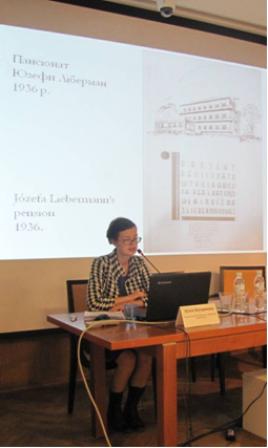 “Ryszard Hermelin and Zygmunt Sperber were successful, young architects who worked in Ukraine in the interwar period. However, today they and their architectural projects are little known.
“Ryszard Hermelin and Zygmunt Sperber were successful, young architects who worked in Ukraine in the interwar period. However, today they and their architectural projects are little known.
Both were Polish Jews, though of assimilated families, as evidenced, among other, Polish names of both architects. Both studied at The Lviv Polytechnic, but at different times. Sperber was 17 years older than Hermelin.
Zygmunt Sperber (born on October 7, 1886 in Stanislaviv) received a license pursuant to the profession in 1923. He was running his architectural bureau, located at 4 Zimorovicza St., already in the 1920s. Beside his architectural work, along with other Jewish architects, he was in charge of architectural monuments in the framework of ‘The Committee for Care of the Monument of Jewish art’, founded in 1925 on the initiative of Józef Avin under the direction of Professor Maurycy Allerhand. Beside the full-scale architectural projects, he executed many small constructions and design works, such as restructuring or development of existing buildings or portions thereof, design of portals, store signage, cinema posters, etc. In 1928, he applied for a construction permit for his own house, which he managed to accomplish only 10 years later...”
Dr. Bohdan Hoi of The Lviv Polytechnic National University delivered a lecture “Theatres and Other Public Buildings in Ukrainian and Jewish Communities.”

Dr. Ihor Zhuk of The Ukrainian Catholic University in Lviv presented a lecture “The Builder Ivan Levynskyi and Urban Communities of Lemberg, 1880–1910.”
 “In 1901, the leading architect of Lviv, Ivan Levynskyi was fifty years old, and he was on the peak of his professional career. The scope of his activity as a construction entrepreneur and industrialist was sticking, he was almost unbeatable.
“In 1901, the leading architect of Lviv, Ivan Levynskyi was fifty years old, and he was on the peak of his professional career. The scope of his activity as a construction entrepreneur and industrialist was sticking, he was almost unbeatable.
Levynskyi has recently completed the construction of the Municipal Theatre (1897–1900), the Mikolasz Passage (1899–1901), the Georges Hotel (1900–1901), he was accomplishing the compound of the Jewish Hospital (1899–1903), and was starting the Central Railway Station in Lviv (1901–1904).
That year, the Lviv newspaper of Ukrainian Russophiles, Halychanyn wrote:
"Architect Ivan Levynskiy belongs to those, once numerous Russian people, who in cold and hunger attended schools, and featured solidity, diligence, and basic knowledge of school disciplines. As a scrupulous and talented architect and businessman, shortly he became famous for his solid, firm, practical, and the same time inexpensive construction. Moreover, Levynskyi proved himself as a talented and artful man advancing his business, since he founded – without significant capital – two tile factories, which are fairly growing. In Lviv, Levynskyi has built, among others, the new Polish theatre, the Georges Hotel, the medical clinics, the Jewish Hospital and many other beautiful and huge buildings. "
The sixth session, mediated by Dr. Lukasz Jasina of The Catholic University of Lublin, was dedicated to Art in Transition.
Prof. Jakub Lewicki of The University of Cardinal Stefan Wyszyński in Warsaw delivered a lecture “Jewish Architects’ Works in Lviv and Beyond: A Unique Phenomenon or Typical Case?”
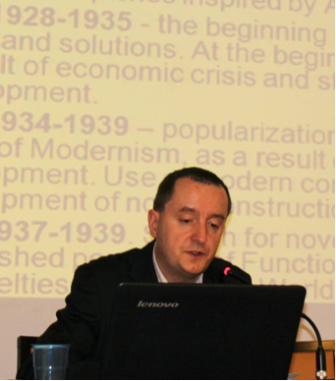 “The main aim of this speech is an attempt to analyze whether the architecture created by Jewish architects of Lviv school of architecture was original or typical.
“The main aim of this speech is an attempt to analyze whether the architecture created by Jewish architects of Lviv school of architecture was original or typical.
The analysis will be based on selection of different buildings erected in the 19th and 20th centuries. The most important part will be presentation of interwar housing architecture accompanied by comparative study between objects erected in the different areas of the Central Europe and Poland, most prominently in Eastern Poland (Lviv area) and Western Poland (the industrial areas of Katowice, Silesia and Poznań).”
“Many elements used by Jewish architects and developed by Lviv school of architecture were adopted later on by other architects. Interwar architecture created by Jewish architects of Lviv school of architecture is very characteristic and forms an important part of architecture legacy created in Central Europe in the first half of 20th century. Whether this phenomenon was new or typical needs further detailed analysis and explanation, which will be provided in following presentation…”
Dr. Yevgen Kotlyar of The Kharkiv State Academy of Design and Arts presented a lecture “Lviv to New York: The Galician Synagogue Paintings in Jewish Emigrant’s Synagogues from the late 1800s to the 1930s.”
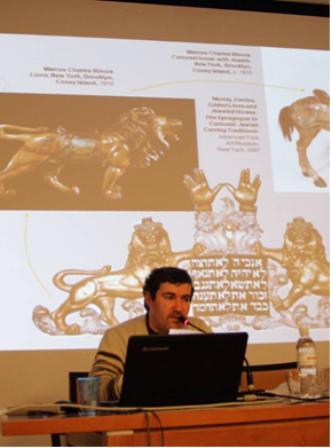 “In Jewish history of America and New York, a special role belongs to the Lower East Side District, which became a place of memory of the American Jewish immigration. It represents one of the main attractions of the Lower East Side – the Museum at Eldridge Street, located in the first American synagogue, built by Eastern European Jews in 1887. During a visit to the synagogue a guide will certainly sharpen visitors’ attention on one of the key motifs in the paintings of the prayer hall - two drawn parallel windows, covered by curtains. In his story he will explain their presence by deep mysticism of Eastern European Jewry. This motif symbolizes connection of the physical world with the divine and looks outdated in the interior of this magnificent building; it looks more like a Reformist’s Temple rather than Orthodox synagogue. It reflects the cultural world of the shtetl, its religious spirit, imbued with messianic hopes for the redemption from Galut. At 200 meters from the synagogue is another beautiful monument - Bialystoker Shul – a Synagogue of the Galician Jewish immigrants, now the Polish city of Bialystok. It was founded in 1905 in a building purchased from protestant church, and beautiful decorations remained in its interior, created in the 1930s and 40s, in the Great Depression for the moral support of American Jews in memory of their historical heritage…”
“In Jewish history of America and New York, a special role belongs to the Lower East Side District, which became a place of memory of the American Jewish immigration. It represents one of the main attractions of the Lower East Side – the Museum at Eldridge Street, located in the first American synagogue, built by Eastern European Jews in 1887. During a visit to the synagogue a guide will certainly sharpen visitors’ attention on one of the key motifs in the paintings of the prayer hall - two drawn parallel windows, covered by curtains. In his story he will explain their presence by deep mysticism of Eastern European Jewry. This motif symbolizes connection of the physical world with the divine and looks outdated in the interior of this magnificent building; it looks more like a Reformist’s Temple rather than Orthodox synagogue. It reflects the cultural world of the shtetl, its religious spirit, imbued with messianic hopes for the redemption from Galut. At 200 meters from the synagogue is another beautiful monument - Bialystoker Shul – a Synagogue of the Galician Jewish immigrants, now the Polish city of Bialystok. It was founded in 1905 in a building purchased from protestant church, and beautiful decorations remained in its interior, created in the 1930s and 40s, in the Great Depression for the moral support of American Jews in memory of their historical heritage…”
Dr. Lukasz Jasina delivered a lecture “Paul Muni: A Hollywood Star from Lemberg and His Yiddish Heritage.”

“We – the people who can be called Central-European cinemaholics – have one, big complex. The name of this complex is simple – Hollywood. Our problems would not be so great if we found out how strongly Hollywood is connected with our lands. The one of the most important examples is a background of Paul Muni.
Paul Muni is a forgotten superstar, the actor whose position whose position in Hollywood during the period of great producers – was more than strong and important. He was considered one of the most prestigious actors at Warner Brothers studios, and one of the rare actors who was given the privilege of choosing which parts he wanted Paul Muni became a symbol of actor’s art and great knowledge of acting. Paul Muni always was proud of his rots. Those roots were from Yiddish theatre in Austro-Hungarian Lemberg.
Muni’s acting quality was legendary. He was usually playing a powerful characters, such as Scarface, was partly a result of his intense preparation for his parts, often immersing himself in study of the real character's traits and mannerisms. He was also highly skilled in using makeup techniques, a talent he learned from his parents, who were also actors, and from his early years on stage with the Yiddish Theater, in New York. At the age of 12, he played the stage role of an 80-year-old man; in one of his films, Seven Faces, he played seven different characters…”
Mrs. Nadia Watson, an independent researcher from York (UK) and Brisbane (Australia), delivered her lecture “Osyp Petriwskyj: Artist and Educator in Lviv and Abroad.” She spoke from Australia on Skype.
 “Osyp Petriwskyj was a professor of fine arts in the Lviv area, and a regional director of art education in western Ukraine, in the 1930s and early 1940s, but fled Soviet Ukraine in 1944, with his wife and young family. They lived in displaced persons camp arrangements in Europe, including a stay in Bamburg in Germany for a short time, and eventually settled in Australia as refugees in 1949. The area where they settled attracted a community of displaced Ukrainians, and Osyp and his wife Maria were committed to ensuring that traditions in the arts – both visual and dramatic – continued to be maintained in this new community in the Diaspora…”
“Osyp Petriwskyj was a professor of fine arts in the Lviv area, and a regional director of art education in western Ukraine, in the 1930s and early 1940s, but fled Soviet Ukraine in 1944, with his wife and young family. They lived in displaced persons camp arrangements in Europe, including a stay in Bamburg in Germany for a short time, and eventually settled in Australia as refugees in 1949. The area where they settled attracted a community of displaced Ukrainians, and Osyp and his wife Maria were committed to ensuring that traditions in the arts – both visual and dramatic – continued to be maintained in this new community in the Diaspora…”
There is not a great deal of information recorded about his work, particularly his career in Ukraine. This paper is a gathering together of the fragments of oral history that have been collected from his family…”
The conference sessions were followed by an evening event. That was a concert of klezmer music, performed by Mr. Ronald Grun (clarinet) and Mrs. Maurizia Dalla Volta (flute), who came from Paris, and by Mrs. Hanna Palmon (piano), who came from Jerusalem. They were able to prepare seven musical pieces, using the Internet, Skype, and having few rehearsals in Lviv. The musicians’ trip to Lviv was sponsored by The Jewish Galicia and Bukovina Association. The concert hall was kindly proposed by The Solomiya Krushelnytska Musical Memorial Museum. One musical piece, played by the trio, the wedding hora called Firn di Mechitonem, may be watched here.
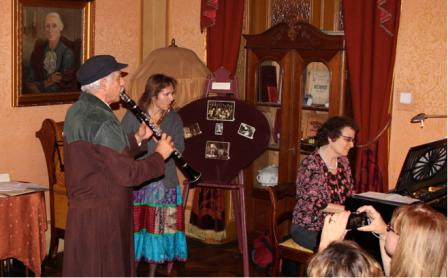 From left to right: Ronald Grun, Maurizia Dalla Volta, and Hanna Palmon performing the hora
From left to right: Ronald Grun, Maurizia Dalla Volta, and Hanna Palmon performing the hora
 The audience warmly greeted the musicians
The audience warmly greeted the musicians
The evening event was concluded at the morning session, Urban Heritages: Tradition, Preservation, Modernity, mediated by Dr. Bohdan Shumylovych of The Center for Urban History of East Central Europe. The session started with the lecture by Ronald Grun of The International Odessa Klezmer Orchestra in Paris, entitled “Klezmer Music in Transition from Eastern European to Western Milieu.”
 “This is the story about Klezmer Music. And its transition from Eastern Europe, to America and back again to Europe. Klezmer music is Jewish Ashkenaze folk music. If folk music is the soul of a culture, Klezmer is Jewish Soul Music. The word Klezmer comes from two Hebrew words: kli and zemer. Meaning “instrument of music” or “vessel of music,” it can refer to a musician or musical instrument.
“This is the story about Klezmer Music. And its transition from Eastern Europe, to America and back again to Europe. Klezmer music is Jewish Ashkenaze folk music. If folk music is the soul of a culture, Klezmer is Jewish Soul Music. The word Klezmer comes from two Hebrew words: kli and zemer. Meaning “instrument of music” or “vessel of music,” it can refer to a musician or musical instrument.
Klezmer is popular all over Europe. Thanks to the internet and You Tube, I know that Lviv has a yearly Klezmer festival featuring local talents and great bands from surrounding countries. It’s popular in Paris, where I live. But I believe this popularity is rather recent. Maybe around 20 years old. After World War II it had disappeared here in Europe. The spark was kept alive in America and rekindled in the 1970’s and exported back to Europe. It reminds me of the story of the French Bordeaux wines. From 1875 to 1892 all of the French Bordeaux vineyards were ruined by an infestation of Phylloxera fungus. The region’s wine industry was rescued by importing pest resistant American rootstock that had originally come from France. All the Bordeaux vines that exist today are a product of that action…”
Dr. Vita Susak of The Lviv National Art Gallery delivered a lecture “The Lviv National Gallery of Art (1907–2012): The Collection and Urban History.”
 “The 20th century occupied a special place in history of Lviv, and Lviv was a very special case in the history of that century. The city, which remained on that very valleys and hills, has changed its state affiliation five times, becoming consequently an Austrian, Polish, Soviet, German, again Soviet, and Ukrainian city. These changes provoked altering of social spaces of the Galician capital, altering its ethnic dominants. The statement by French sociologist Henri Lefebre (“The Production of the Space” /La production de l'espace, 1974, p.33, 50) became classic: “Every society produces a space, its own space, ... and in spational practice the reproduction of social relations is predominant.” This relationship and domination have been cast on the exterior – in Lviv architecture, and the interior – in archives, libraries, museum collections, in history of their collecting, splitting, contributing, confiscating and (re)orienting. All these directly concerns the museums – historical, ethnographical, and art museums alike. While visiting art museums, where the best artworks from their collections are simply exposed, we understand that they are exposed not “simply,” and that the museum halls are the representational space of that social realm, to which they belong in the moment, and this representational space achieves symbolic force.
“The 20th century occupied a special place in history of Lviv, and Lviv was a very special case in the history of that century. The city, which remained on that very valleys and hills, has changed its state affiliation five times, becoming consequently an Austrian, Polish, Soviet, German, again Soviet, and Ukrainian city. These changes provoked altering of social spaces of the Galician capital, altering its ethnic dominants. The statement by French sociologist Henri Lefebre (“The Production of the Space” /La production de l'espace, 1974, p.33, 50) became classic: “Every society produces a space, its own space, ... and in spational practice the reproduction of social relations is predominant.” This relationship and domination have been cast on the exterior – in Lviv architecture, and the interior – in archives, libraries, museum collections, in history of their collecting, splitting, contributing, confiscating and (re)orienting. All these directly concerns the museums – historical, ethnographical, and art museums alike. While visiting art museums, where the best artworks from their collections are simply exposed, we understand that they are exposed not “simply,” and that the museum halls are the representational space of that social realm, to which they belong in the moment, and this representational space achieves symbolic force.
Collection of the Lviv Art gallery, and the way it was presented to the visitors on diverse stages of its history, followed all the historical zigzags passed by the city…”
Dr. Iryna Horban’ of The Museum of Ethnography and Arts and Crafts, Ethnology Institute of National Academy of Sciences of Ukraine in Lviv, delivered a lecture “The Museums of the Ukrainian and Jewish Communities of Lviv in the first half of the 20th Century.”
 “During the first third of the 20th century, Lviv impressively championed in the museum realm of Galicia, and it was holding the leading position in the quantity of museums of various forms of ownership, as well as in the significance of the stored artifacts. The specifics of Lviv as a multiethnic city had its impact in this sphere, too. Due to the dominance of Poles in the upper echelons of the society, a large faction of museums could be characterized as Polish collections.
“During the first third of the 20th century, Lviv impressively championed in the museum realm of Galicia, and it was holding the leading position in the quantity of museums of various forms of ownership, as well as in the significance of the stored artifacts. The specifics of Lviv as a multiethnic city had its impact in this sphere, too. Due to the dominance of Poles in the upper echelons of the society, a large faction of museums could be characterized as Polish collections.
The rise of the Ukrainian movement, its modern ideology associated with the desire to declare their national identity, urged the Ukrainian urban community to establish their museums. The centers of collecting and preservation of Ukrainian monuments of history and culture emerged in Lviv already in the mid-19th century.
Thus, the first artifacts arrived to the museum of the Ruthenian National Institute, Narodnyi Dim, in the early 1850s. The new acquisitions were voluntarily donated by Ukrainian priests and public activists, and they enabled formation of the archaeological, natural, and numismatic collections, as well as art gallery. However, the conflict among representatives of the National Institute had its negative impact on the museum activity, and the latter was opened to public only on June 16, 1904…”
Dr. Oksana Boyko of The Institute “Ukrzakhidproektrestavratsiia” in Lviv delivered a lecture “Methods of Restoration of Synagogues in Galicia in the 19th – First Half of the 20th Century.”
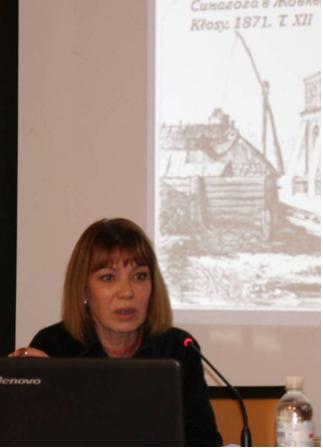 “Revolutionary processes, which swept Europe in the 19th century, gave an impulse to the search for national identity in architecture, also in the architecture of sacred buildings. The colorful centers of particular ethnic communities produced new national styles: the Neo-Polish, or the Zakopane Style, the Neo-Romanian (the Neo-Brâncoveanu), the Neo-Ukrainian (Neo-Byzantine) as well.
“Revolutionary processes, which swept Europe in the 19th century, gave an impulse to the search for national identity in architecture, also in the architecture of sacred buildings. The colorful centers of particular ethnic communities produced new national styles: the Neo-Polish, or the Zakopane Style, the Neo-Romanian (the Neo-Brâncoveanu), the Neo-Ukrainian (Neo-Byzantine) as well.
The emancipation processes, which impacted the Jews, were reflected in ultra-modern trends. Many new sacred buildings, including synagogues, were constructed in the late 19th century. That same period, the old sacred monuments were reconstructed and restored, and expressive features of historical styles or modern trends were applied to them.
The methodologies of restoration included the following:
historical stylization (Zhovkva, Meissen, Przemyśl);
symbolic stylization (the Temple Synagogue of Lviv);
modernization of historical buildings (the Lviv Suburban Synagogue, the synagogue of Yazlivets)….”
The eighth, and the concluding session of the conference, City and Destiny, was mediated by Dr. Sergey Kravtsov.
Mrs. Hanna Palmon, a musician and an independent researcher from Jerusalem, delivered a lecture “Natan Hermelin (1878–1941) and Arthur Hermelin (1901–42), Jewish Musicians in Lviv.”
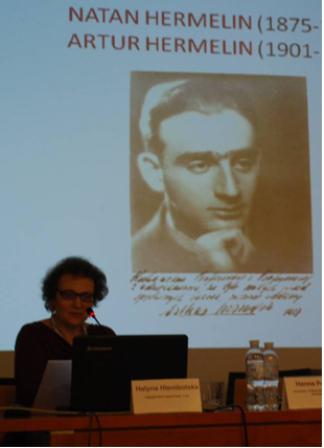 “The pianist I am going to tell about – Artur Hermelin – was born in Przemyśl, but his childhood and youth were spent here, in Lemberg. His grandfather Baruch-David Hermelin was a Hasid of the Belz rabbi and the author of a Halachic book; his uncle was a successful gynecologist in Lemberg; his father – a lawyer, violinist, composer and orchestra conductor; his brother – an architect; so the Hermelin family fulfilled what many Jewish families in Galicia tried to fulfill along the 19th century: embracing and putting into practice the Haskala ideas, namely taking any reasonable steps in order to become an integral part of their national and cultural environment, moreover: to become productive members in it. Officially, that environment, Lemberg, turned Polish after World War I, but in fact, it must have continued being multicultural – with its Ruthenian population and long-established minorities of Armenian, Karaite, German, Czech and other ethnic groups; and about one third of its population was Jewish: Hassidim of different Hassidic courts, non-Hassidic Orthodox called “Misnagdim,” “Maskilim” (emancipated Jews who struggled for secular education and deep reforms in the Jewish ways of life), “Mitbolelim” (assimilated Jews, frequently converted to Christianity), and early Zionists. Artur grew up in an emancipated Austrian Jewish family with Hassidic memories until 1919; but as soon as the age of 12 (in 1914) – his musical environment turned relatively Polish (for example, his very influential piano teachers were Leszetycki and Lalewicz)...”
“The pianist I am going to tell about – Artur Hermelin – was born in Przemyśl, but his childhood and youth were spent here, in Lemberg. His grandfather Baruch-David Hermelin was a Hasid of the Belz rabbi and the author of a Halachic book; his uncle was a successful gynecologist in Lemberg; his father – a lawyer, violinist, composer and orchestra conductor; his brother – an architect; so the Hermelin family fulfilled what many Jewish families in Galicia tried to fulfill along the 19th century: embracing and putting into practice the Haskala ideas, namely taking any reasonable steps in order to become an integral part of their national and cultural environment, moreover: to become productive members in it. Officially, that environment, Lemberg, turned Polish after World War I, but in fact, it must have continued being multicultural – with its Ruthenian population and long-established minorities of Armenian, Karaite, German, Czech and other ethnic groups; and about one third of its population was Jewish: Hassidim of different Hassidic courts, non-Hassidic Orthodox called “Misnagdim,” “Maskilim” (emancipated Jews who struggled for secular education and deep reforms in the Jewish ways of life), “Mitbolelim” (assimilated Jews, frequently converted to Christianity), and early Zionists. Artur grew up in an emancipated Austrian Jewish family with Hassidic memories until 1919; but as soon as the age of 12 (in 1914) – his musical environment turned relatively Polish (for example, his very influential piano teachers were Leszetycki and Lalewicz)...”
Mrs. Halyna Hlembotska, an independent researcher from Lviv, delivered a lecture “Jewish Architects and Artists in the Janowska Concentration Camp.”
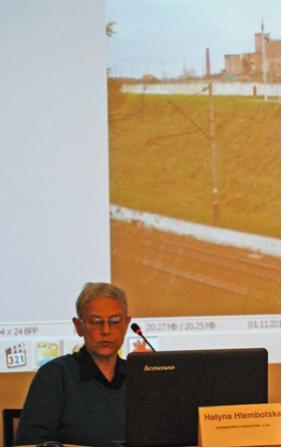 “During last sixty years, a number of books were dedicated to the Holocaust in Lviv. The most significant among them were The Murder of the Lviv Jews by Filip Friedman (Łódź, 1945), Lvov Ghetto Diary by David Kahane (Jerusalem, 1987; Ukrainian translation of 2003), Smoke In The Sand: The Jews Of Lvov In The War Years 1939-1944 by Eliyahu Yones (Jerusalem, 1993; Russian translation of 1999), as well as works by the Lviv researcher Yakov Honigsman: The Catastrophe of Jewry of Western Ukraine. The Jews of Eastern Galicia, Bukovina, and Trans-Carpathian Area in 1933-1945 (Lviv, 1998), and The Janowska Hell (Lviv, 2003). The latter was dedicated to the Janowska Road Camp. The aforementioned works mention hundreds of names of the Lviv Jews, who perished during World War II. However, there practically no names of artists, neither architects. In my present paper, I wish to fix, at least partially, this injustice…”
“During last sixty years, a number of books were dedicated to the Holocaust in Lviv. The most significant among them were The Murder of the Lviv Jews by Filip Friedman (Łódź, 1945), Lvov Ghetto Diary by David Kahane (Jerusalem, 1987; Ukrainian translation of 2003), Smoke In The Sand: The Jews Of Lvov In The War Years 1939-1944 by Eliyahu Yones (Jerusalem, 1993; Russian translation of 1999), as well as works by the Lviv researcher Yakov Honigsman: The Catastrophe of Jewry of Western Ukraine. The Jews of Eastern Galicia, Bukovina, and Trans-Carpathian Area in 1933-1945 (Lviv, 1998), and The Janowska Hell (Lviv, 2003). The latter was dedicated to the Janowska Road Camp. The aforementioned works mention hundreds of names of the Lviv Jews, who perished during World War II. However, there practically no names of artists, neither architects. In my present paper, I wish to fix, at least partially, this injustice…”
“The artist Jakub Glasner was among those 130,000 Jewish refugees, who found themselves in Lviv in 1939…”
“In 1985, the Lviv Ukrainian artist Roman Selskyi, the husband of artist Margit Reich, told how Gestapo arrested his wife and imprisoned her at Janowska…”
“The artist Józef Malerman perrished in Janowska Camp in 1943 or 1943...”
“Among those, who passed through the Janowska Camp and lost thier lives in the Bełżec Death Camp, was the Lviv architect and contractor, an owner of a building firm, an author of numerous housing and industrial projects, as well as synagogues, Albert Korblüth..”
The conference was concluded by words of gratitude to all the lecturers and participants. The organizers promised publication of the conference volume, and shared their plans for a new conference.


